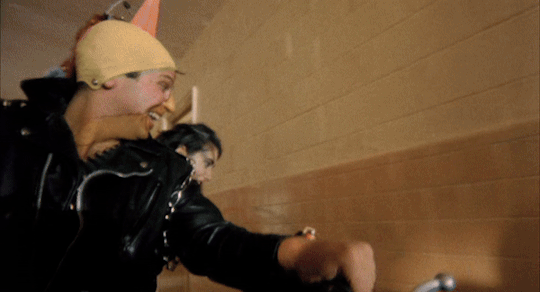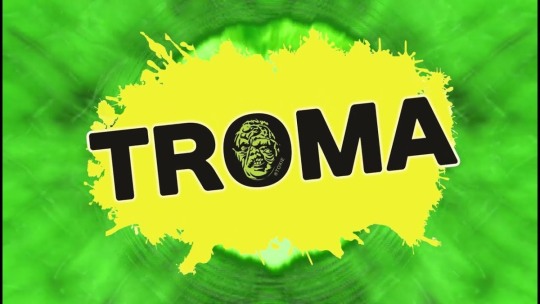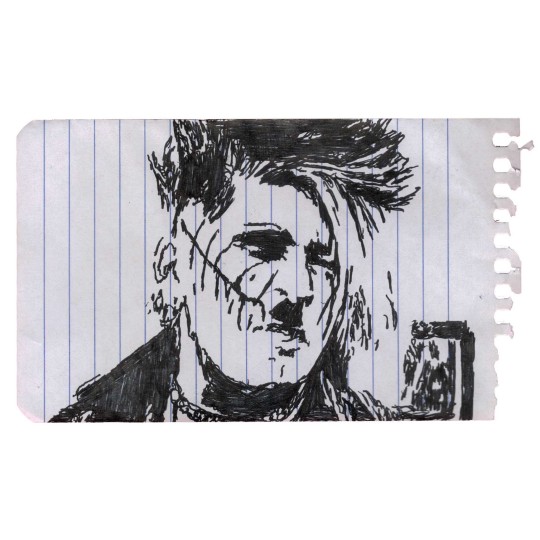#Richard W Haines
Explore tagged Tumblr posts
Photo

Class of Nuke ‘Em High (1986)
Dir. By Lloyd Kaufman (Samuel Weil) & Richard W. Haines
#Class of Nuke 'Em High#Nuke 'Em High#Tromaville#Troma Entertainment#Llyod Kaufman#Richard W Haines#Michael Herz
48 notes
·
View notes
Text

Alien Space Avenger | 1989
#Alien Space Avenger#practical effects#skull#horror comedy#Richard W. Haines#horror#horror movies#hammersmith horror#80s horror#vhs#gross#lfg#brain
853 notes
·
View notes
Text




Class of Nuke 'Em High (1986) directed by Richard W. Haines and Lloyd Kaufman
Why don't you make like a hockey stick, and puck off!
#80s#gifs#the gifs of ghoulbones#gif#animated gifs#horror movies#1980s#class of nuke 'em high#richard w. haines#lloyd kaufman#1986#cult movies#troma films#troma entertainment#troma#horror comedy#trash aesthetic#rick howard#spud#muffey#Théo Cohan
40 notes
·
View notes
Text
On May 11, 1986 Class of Nuke 'Em High premiered at the Cannes Film Market.


#class of nuke 'em high#richard w. haines#lloyd kaufman#troma films#tromaville#troma entertainment#troma#troma film#dystopian sci fi#dystopian science fiction#dystopian film#splatterpunk#splatter movie#splatter movies#teensploitation movies#teensploitation#80s comedy movies#comedy movies#cult classic#cult movies#cult film#stoner movies#stoner art#stoner movie#movie art#art#drawing#movie history#pop art#modern art
12 notes
·
View notes
Text
WHAT REALLY FRIGHTENS YOU reviews - free on Tubi, YouTube
‘Never tell a soul’ What Really Frightens You is a 2009 horror film co-produced, written and directed by Richard W. Haines (Alien Space Avenger; Class of Nuke ‘Em High; Splatter University). The movie stars Jennifer Sorika Wolf, Postell Pringle, Ian Tomaschik and Patrick Flynne. Plot: The “Ghost Writer” (Ian Tomaschik) pitches an article to Ghastly Horror magazine editor Marshall McFarland…
#2009#Fear#free on YouTube#free online#Ian Tomaschik#Jennifer Sorika#movie film#Postell Pringle#Richard W. Haines#What Really Frightens You?
0 notes
Text
My Top 5 Troma Movies
My Top 5 Troma Movies #Cinema #FilmReview #MovieReview
Troma Entertainment is a film production company known for its low-budget, independent, and often controversial movies. Here are five of my favourite Troma movies, in no particular order: The Toxic Avenger (1984) Directed By – Michael Herz & Lloyd Kaufman Starring – Mitch Cohen, Mark Torgl, Andree Maranda, Pat Ryan Jr This movie tells the story of a scrawny, bullied janitor who becomes a…

View On WordPress
#Allyson Sereboff#Andree Maranda#Bill Weeden#Class of Nuke &039;Em High#Gabriel Friedman#Gil Brenton#Jane Jensen#Janelle Brady#Jason Yachanin#Kate Graham#Lloyd Kaufman#Mark Torgl#Maximillian Shaun#Michael Herz#Mitch Cohen#Op-Ed#Op-Eds#Pat Ryan#Pat Ryan Jr#Richard W. Haines#Rick Gianasi#Robert Prichard#Robin Watkins#Susan Byun#The Toxic Avenger#Thomas Cmkovich#Troma#Valentine Miele#Will Keenan
1 note
·
View note
Text
Class of Nuke 'Em High / Mutantes en la universidad (1986)
Dir. Lloyd Kaufman / Michael Herz / Richard W. Haines


#troma entertainment#troma#tromaville#horror movies#horror lover#horror film#classic horror#lloyd kaufman#80s horror#80s
3 notes
·
View notes
Text
The Mystery of the Mary Celeste

May 11, 2023
The Mary Celeste ship was built in Spencer’s Island, Nova Scotia and was launched under British registration as Amazon on May 18, 1861. On the registration documents the ship was 99.3 feet long, 25.5 feet broad, with a depth of 11.7 feet.
She had previously been in a wreck in Cape Breton and was very damaged. In November 1868, a man named Richard W. Haines, from New York paid $1,750 (US) for the wrecked ship and spent $8,825 to restore it. In December 1868, the ship was registered to the Collector of the Port of New York as an American vessel under the name, Mary Celeste. Haines also became the captain of her.
In October 1869, the ship was seized from Haines and sold to a New York consortium. For at least three years there is no record of Mary Celeste’s trading activities. In 1872, she underwent a refit that cost $10,000 and her size was increased, and the new captain’s name was Benjamin Spooner Briggs.
In October 1872, Briggs, his wife, and infant daughter took Mary Celeste on her first voyage, after her New York refit, to Genoa, Italy. Briggs had left his school aged son behind to be taken care of by his grandmother.
Briggs chose the crew for the voyage himself, including first mate Albert G. Richardson, second mate Andrew Gilling, 25 years old, the steward was Edward William Head, and four seamen who were German from the Frisian Islands: brothers Volkert and Boz Lorenzen, Arian Martens, and Gottlieb Goudschaal. Briggs and his wife were extremely satisfied with the crew.
On October 20, 1872, Briggs went to Pier 50 on the East River in New York City to supervise the ship loading 1,701 barrels of alcohol. Briggs’ wife and infant joined him a week later.
On Tuesday, November 5, 1872, Mary Celeste left Pier 50 and went into New York Harbor. The weather was uncertain, so they waited for better conditions. After two days, the weather was good enough to begin the voyage, and so Mary Celeste sailed into the Atlantic.
A Canadian ship, Dei Gratia was nearby in Hoboken, New Jersey, waiting on cargo before they set sail. The Captain, David Morehouse, and first mate Oliver Deveau were Nova Scotians who were highly experienced. It was even rumoured that Captain Morehouse and Briggs were friends and had dined together the night before Mary Celeste departed, however the evidence of this comes from Morehouses’ widow 50 years after the event.
Dei Gratia departed for Gibraltar on November 15, 1872, following the same route as Mary Celeste had seven days earlier.
On December 4, 1872, between the Azores and the coast of Portugal, Captain Morehouse on the Dei Gratia was made aware that there was a vessel heading unsteadily towards them about 6 miles away. The ship appeared to be making erratic movements, leading Morehouse to believe something must be wrong.
Captain Morehouse noticed there was nobody on deck when the ship came closer, and they were receiving no replies from their signals. Captain Morehouse sent Deveau and his second mate John Wright in a boat to investigate the strange vessel.
The two men discovered that this vessel was indeed the Mary Celeste, as the name was on her stern, so they climbed onto the ship and found that it had been completely deserted; there was not one person around. The sails were partly set and in poor condition, some were completely missing and a lot of the rigging had been damaged, with ropes hanging over the sides. The ship had a single lifeboat that was missing. The binnacle that had the ship’s compass in it was out of place and the glass cover was broken.
There was 3.5 feet of water in the hold, however that was not suspicious for a ship of that size. A makeshift sounding rod which measures the water in the hold was found abandoned on the deck.
The Mary Celestes’ daily log was in the mate’s cabin, and the final entry date had been at 8 am on November 25, nine days before the ship was discovered. The position was recorded to be about 400 nautical miles from the point where Dei Gratia had found her.
Deveau reported that the inside of the cabin had been wet and untidy from water that had come in through doorways and skylights, however it was mostly in order. There were personal items scattered in Captain Briggs’ cabin, however most of the ship’s papers were missing, along with navigational instruments.
There was no obvious signs of fire or violence, and there was no food prepared or being prepared. It appeared that there had been an orderly departure from the Mary Celeste, the crew using the missing lifeboat.
Captain Morehouse decided to bring Mary Celeste to Gibraltar, which was 600 nautical miles away. Under maritime law, a salvor could get a decent amount of money of a rescued vessel and cargo.
Morehouse divided his crew, and sent 3 members on the Mary Celeste, which he and four other members stayed on the Dei Gratia; however this meant that each ship was very under crewed. Dei Gratia arrived at Gibraltar on December 12, while Mary Celeste arrived the next day due to fog.
The salvage court hearings began on December 17, 1872, Captain Morehouse had written to his wife that he believed he would be paid well for the Mary Celeste salvage. Testimony from Deveau and Wright convinced the court that a crime had been committed, foul play was involved.
On December 23, 1872, there was an examination of Mary Celeste, which reported that there were cuts on each side of the bow, caused by what they thought a sharp instrument. There was also what appeared to be possible traces of blood on Captain Briggs’ sword.
The report stated that the ship did not appear to have been struck by heavy weather, or been involved in a collision. A group of Royal Naval captains also examined the ship and said the cuts on the bow seemed to be caused deliberately. There was also stains on one of the ship’s rails that might have been blood, with a deep mark possibly caused by an axe.
On January 22, 1873, the reports from the court hearings were sent to the Board of Trade in London, with Frederick Solly-Flood, the Attorney General of Gibraltar concluded that the crew on the Dei Gratia had wanted to steal the alcohol on the Mary Celeste, and murdered Captain Briggs’ and his crew in a drunken frenzy. Flood believed that Captain Morehouse and his men were hiding something, that the daily log of where the Mary Celeste had been had been doctored. Flood did not believe that the ship could have travelled 400 nautical miles while being uncrewed.
It was discovered that what appeared to be “blood stains” were in fact not blood, which setback Flood’s theory of murder. Another blow was when Captain Shufeldt of the US Navy reported the marks on the bow were not man-made, but came from natural actions of the sea.
There was nothing concrete, so Flood had to release the Mary Celeste from the court’s jurisdiction on February 25, 1873. The salvage payment was decided on April 8, 1873, the award was about one-fifth of the total value of ship and cargo, far lower than what was expected.
While Flood’s theories of murder were not very convincing, there was still suspicion that the ship had met foul play of some sort. Some believed that Briggs and Morehouse were involved together, wanting the money, but it doesn’t make sense that they would have planned such an attention drawing event. Others also comment that if Briggs wanted to disappear permanently he wouldn’t of left his young son behind with his mother.
Some believed the Mary Celeste was attacked by Riffian pirates who were active off the coast of Morocco in the 1870′s, however this has been largely dismissed because pirates would have looted the ship, yet the captain’s personal possessions were found; some which had significant value.
A New York insurance appraiser named Arthur N. Putman, was a leading investigator in sea mysteries in the early 20th century. He proposed a lifeboat theory, stating that only one single lifeboat had been missing, the rope had been cut, not untied, which meant that when the Mary Celeste was abandoned, it happened very quickly.
There was multiple times in the ship’s logs where it was mentioned there was ominous rumbling and small explosions from the hold. Putman believed that the alcohol on ship gave off explosive gas and one day there was a more intense explosion of this. A sailor perhaps went below deck with a light or a lit cigar which set off fumes causing an explosion that was violent enough to blow off the top covering on the hatch, explaining why it was found in an unusual position. Putman believes Briggs and the crew were in a panic and piled into one lifeboat, abandoning Mary Celeste.
Deveau, who was one of the men who examined the abandoned ship on sea, proposed that Briggs abandoned the ship after false sounding, there might of been a malfunction of the pumps or another mishap, giving the impression the ship was taking on water at a rapid pace, the crew might have assumed the ship was in danger of sinking.
Mary Celeste made her way to Genoa, and then left on June 26, 1873. She arrived in New York on September 19, 1873. Due to the Gibraltar hearings and newspaper stories she became quite unpopular, nobody wanted her. In February 1874, Mary Celeste was sold at a considerable loss to a partnership of New York businessmen.
Mary Celeste sailed mainly in the West Indian and Indian Ocean routes, but was losing a lot of money. In February 1879, her captain was a man named Edgar Tuthill, who had fallen ill. Tuthill died and some believed the ship was cursed, as he was the third captain who had died prematurely.
In August 1884, a new captain named Gilman C. Parker took on the ship. On January 3, 1885, Mary Celeste approached a large coral reef, the Rochelois Bank, where she purposely ran into it, ripping out the bottom and wrecking her beyond repair. The crew then rowed themselves ashore, and sold what was left of the cargo for $500.
In July 1885, Parker and his shippers were tried in Boston for conspiracy to commit insurance fraud, with Parker also being charged with “wilfully casting away the ship” which was known as barratry, which you could be sentenced to death for.
On August 15, 1885, the jury could not agree on a verdict. Instead of having another trial, which cost a lot of money, the judge negotiated an arrangement where Parker and his crew withdrew their insurance claims and repaid what they got. The barratry charge was deferred and Parker was set free, though his reputation was ruined.
Parker died in poverty three months later, one of the co-defendants went mad and another ended his life. This further caused people to believe Mary Celeste was cursed.
At Spencer’s Island, Mary Celeste and her lost crew are commemorated by a monument, and by a memorial outdoor cinema built in the shape of the vessel’s hull. The fate of the crew of the Mary Celeste have never been discovered, and over 150 years later, it is unlikely we will ever discover the truth.
#mystery#unsolved#UNSOLVED MYSTERIES#unsolved crime#unsolved case#ship#vessel#true crime#Crime#sail#mary#celeste
21 notes
·
View notes
Text

"Alleged Slayer of Policeman Is Caught," Kitchener Record. May 9, 1934. Page 1 & 15. ---- TEMPLE CAPTURED AFTER LONG CHASE ---- Arrested At Home Of Friend In West Lorne 40 Hours After Shooting --- APPEARS IN POLICE COURT --- --- Farm Boy Near Dutton Prods Fugitive, Hiding In Haymow, With Fork
ST. THOMAS, May 9. - (CP)- Outwardly cool and collected, smiling at the police officers and whispering some comment to Inspector T. W. Cousins, as he entered the prisoner's box, Frank Mactemple alias Frank Temple, was arraigned before Magistrate C. F. Maxwell on a charge of murdering Constable Colin C. McGregor of the city police force, in city police court today and was remanded to the county jail for a week without pleading.
Crown Attorney Wilfred Haines stated that in all likelihood at least one more remand will be necessary. He stated that he desired to wait until the inquest is completed. It was adjourned, Tuesday morning. until Friday evening May 18.
Says Name Mactemple The prisoner told Magistrate Maxwell that his surname is "Mactemple" not Temple.
In a calm voice he spelled the name slowly for the court. "Small "t," asked the magistrate, "Yes, a small 't,'" the prisoner replied.
When told that he had the privilege of arranging for counsel, he asked with whom he would make arrangements. The magistrate explained that he could make his own arrangements, and if he was unable to engage counsel, he could take up the matter with Crown Attorney Haines.
"Very well," said Mactemple. "I have one now, I think," he added.
As he was about to leave the box, Mactemple leaned over the rail and told Crown Attorney Haines that he hoped to have C. St. Clair Leitch, K.C., of this city, defend him.
Strongly Guarded The prisoner was strongly guarded when he was brought into the court room and removed, the guard consisting of Provincial Constable Harry Noakes, County Constable Hugh Sharp and Sergeant Josepla McCulley of the city police force He glanced around the court room as he entered, a cheerful looking smile on his lips. There was not an indication of worry of weariness on his face. He did not look like a man who had been hunted by dozens of police officers for nearly 40 hours. As he sat in the box, waiting until Magistrate Maxwell came In, he turned his gaze on the row of newspaper reporters sitting to the right of the prisoner's box, an amused look on his face. He kept his injured right hand cupped in his left hand.
Great crowds of curious people were congressed in the city hall corridors while the brief court proceedings were in progress. They were not permitted to enter the court room. A half dozen or more police officers were at each door of the court room, prepared if Mactemple made any attempt to escape.
At Home Of Friend Temple was captured early today at West Lorne, 40 hours after he fled about his home here following a pistol fight with three officers who sought to arrest him on a charge of bicycle theft.
Temple, whose pistol fire allegedly caused the death of Colin McGregor youngest policeman on the St. Thomas force, wounded another officer and his own son, Fred, was taken at the home of a friend. Richard Carnegie, West Lorne antique dealer.
Chase Through Swamp Twenty-five officers of the St. Thomas, Ontario Provincial and Royal Canadian Mounted Police forces, had chased him through four miles of swamp and dense brushland to Carnegie's house. Temple appeared not to realize his refuge was known. Officers signalled to Carnegie and the antique dealer overpowered him as the officers rushed in.
He was unable to resist or draw the 32 calibre revolver found in his pocket. The pistol contained in its chambers three exploded cartridges and two live ones.
Apparently unconcerned and still truculent, Temple was brought back by automobile, heavily manacled. He was suffering from a wound in his right hand, suffered, police believed, when he resisted arrest with a storm of bullets that enabled him to dart through the back door of his home and main at liberty for hours.
Only Half Block Away In police headquarters this morning Temple sat waiting for a doctor to dress his wounded hand. He was uncommunicative about his wanderings, but revealed he had spent the first night of his flight only half a block from his own home, sleeping in a foundry.
While he rested there police scoured the territory for miles, stopping automobiles, searching trains and jake boats as far west as Port Stanley.
From the time of the fight until he was captured the man had covered only about 30 miles. Officers said they believed he had spent most of his time under cover, making his flight slowly and cautiously. For 40 hours he fled with his wounded hand, fearing to draw police upon him if he sought to have it tended.
Somehow he appeared to have obtained food. He was in good condition when brought here. Officers asked him how he ate while he was a fugitive and he answered gruffly: "How do you suppose?"
"Smart Alec" Police said Temple had vowed he would not be taken for bicycle theft and that he would shoot the first officer who appeared for him. McGregor, it was found yesterday, had been shot with a notched bullet, calculated to inflict the greatest possible injury.
Temple is a lankily built man, apparently capable of considerable speed. His attitude towards his arrest officers described as "inhuman." One policeman said: "He's not a sissy about anything."
His answers to questions caused police to describe him as a "smart Alec."
Temple's capture, affected under leadership of Inspector T. W. Cousans of the London division of the provincial police, came about eight hours after a boy saw him in the haymow of Malcolm McNeil's barn, near Dutton. The boy. a 16-year-old farmhand named Anderson, said he prodded the man with a fork as he was pitching hay.
The boy's story caused officers to concentrate near McNeil's home. They saw a man slip into the bushes at the edge of a four-mile stretch of swamp and pursued him. He beat them across the swamp and took refuge at Carnegie's house, apparently thinking he had outdistanced his pursuers.
Neighbors in Past After his arrest Temple admitted he was the man the boy had seen.
Temple apparently sought aid from Carnegie because he and the antique dealer were neighbors in the past when Temple and his family lived at West Lorne.
Police here are holding all members of Temple's family who were at home during the shooting as material witnesses in the trial. Fred, his son, is under arrest in hospital, charged with bicycle theft and another son, Frank, Jr., is charged with the same offence. Police claimed Fred sought to help his father resist arrest, but said young Frank took no part in the fight.
///
"YOUTH'S DECISION LEADS TO ARREST," Kitchener Record. May 9, 1934. Page 1 & 14. --- What Looked Like Good Forkful Of Hay Proves To Be Frank Temple --- ST. THOMAS, May 9. - (CP) - Decision of Clifford Anderson, 16-year-old farmhand on the farm of Malcolm M. McNeil, Dunwich, just outside Dutton, to remove hay from a certain spot in the mow because It "looked like a good forkful" of hay led to the capture of Frank Temple, 50-year-old alleged slayer of Constable Colin McGregor, today.
To the Canadian Press, a member of the McNeil household reveal- ed the young farmhand's thrilling experience. Malcolm McNeil and his brother had completed their part of the chores for the night and had been called for supper. This was at 6.30 p.m. last night. Clifford went to the mow to throw down the hay for the horses.
Pleads With Youth He was hurrying in order to get to the house with the two men. He picked up the fork, saw the likely-looking bunch of hay and jabbed his fork into it. He uncovered a haggard-looking stranger who had been buried in the hay. Keeping his face averted, the stranger - who proved to be the much-sought Temple - talked to him in low tones, asking him not to tell the "boss" that he was there, Anderson said.
Temple seemed very nervous and on the alert, the farmhand continued. He asked the youth to roll a cigarette for him, and the boy complied. Before reaching for the cigarette, Temple drew a pair of black gloves on his hands evidently to prevent young Anderson from seeing his wounded hand-which Sergeant Sam McKeown hit with a revolver shot during the fracas on Monday which ended in the death of McGregor, and the wounding of McKeown and Fred Temple, son of the man now under arrest.
Wondering about the youth's delay in getting the hay down, Malcolm McNeil mounted the stairs from the lower part of the barn and called to the youth through the opening, telling him to hurry since supper was waiting: Unaware of the fact Temple was present, Mr. McNeil returned to the lower floor of the barn and then proceeded to the house.
Tells Of Discovery Anderson said Temple pleaded with him continually not to tell "the boss" he had uncovered a man in the hay. The aged man did not threaten the youth with violence or display his revolver, the youth said, but continued begging him not to tell anyone what had occurred
The farmhand promised he would not tell Mr. McNeil and was permit ted to leave the barn unmolested. It was not until about two hours later that he told members of the household, and expressed the be lief the man he had uncovered was Temple. Malcolm McNeil immediately telephoned a report to Chief William Ketchabaw of the city police department, giving him the de tails as told by Young Anderson.
#port stanley#st. thomas#fatal shooting#shoot out with police#shoot out#cop killer#wanted fugitive#police raid#armed self defence#gun fight#frank temple#great depression in canada#crime and punishment in canada#history of crime and punishment in canada
1 note
·
View note
Text

Class of Nuke 'Em High (Lloyd Kaufman, Michael Herz, Richard W. Haines, 1986)
0 notes
Video
youtube
THE MOST DANGEROUS PLACE TO WATCH A MOVIE! | 42nd Street Memories | Documentary Review
This is my review for the documentary "42nd Street Memories: The Rise And Fall Of America's Most Notorious Street".
Released in 2015 and directed by Calum Waddell, it's about New York's 42nd Street, located between 7th and 8th Avenue in Midtown Manhattan, where rows of movie theaters across the street from each other offered screening of all the sleazy grindhouse and horror movies you enjoyed from that era.
Until the early 90's when it got shutdown and got Disneyfied and sanitized for your unpleasure.
You'll hear actors, directors, film distributors, producers, authors, film historians talking about their first hand experiences going to see movies on 42nd Street known also as "The Deuce".
People like Frank Hennenlotter, Richard W. Haines, Joe Dante, Larry Cohen, Matt Cimber, Veronica Hart, Debby Rochon, William Lustig, Buddy Giovinazzo, Tom Holland, Lloyd Kaufman, Greydon Clark and Jeff Lieberman.
You can watch it for free on Tubi: https://tubitv.com/movies/616810/42nd-street-memories
Or get it on Blu-ray from the Grindhouse Releasing of "Pieces": https://shop.grindhousereleasing.com/collections/pieces
My Movie Trailers Compilation Collection Video: https://www.youtube.com/watch?v=d6YbegE2NuU
Petter Wellers And Sam Elliott Hanging Out on 42nd Street: https://www.youtube.com/watch?v=jG0US4BQx5Y
My 42nd Street Shirt can be purchased here: https://www.etsy.com/ca/listing/895758784/vintage-new-york-42nd-street-enjoy-a
PLEASE LIKE! SHARE! & SUBSCRIBE!
Merch Store : https://www.etsy.com/shop/GrindhouseFunhouse
• INSTAGRAM: https://www.instagram.com/grindhousefunhouse • FACEBOOK: https://www.facebook.com/grindhousefunhouse • TWITTER: https://www.twitter.com/grindfunhouse • REDDIT: https://www.reddit.com/r/grindhousefunhouse
1 note
·
View note
Photo

77 notes
·
View notes
Photo



Class of Nuke 'Em High (1986)
#class of nuke 'em high#horroredit#lloyd kaufman#richard w. haines#troma entertainment#80s horror#gore#filmedit#Horror Movies#horror#80s
752 notes
·
View notes
Text
On June 3, 1987 Class of Nuke 'Em High was screened at the Night Visions Film Festival.


#class of nuke 'em high#richard w. haines#troma film#troma entertainment#tromaville#troma films#splatter movies#splatterpunk#splatter comedy#splatter film#80s comedy movies#movie art#art#drawing#movie history#pop art#modern art#pop surrealism#cult movies#portrait#cult film
8 notes
·
View notes
Photo


#Class of Nuke 'Em High#Richard W. Haines#Lloyd Kaufman#Samuel Weil#Mark Rudnitsky#Stuart Strutin#Graham Flashner#Troma#80s
72 notes
·
View notes
Text
Toys & Interview w/ Richard W. Haines
Toys & Interview w/ Richard W. Haines
Maybe it’s a horror movie continues! This week, we are doing Toys, starring the late and great, Robin Williams. This inexcusably unsettling movie was a 10-year passion project by writer/ director, Barry Levinson (and then wife, Valerie Cutrin). It is inarguably polarizing, because while it was nominated for a Razzie for worst director, it also received Oscar nominations for Art Direction and…

View On WordPress
1 note
·
View note